Abstract
This paper aims to present a novel airflow-induced acoustic piezoelectric generator that can be used to solve the problem of insufficient power supply of modern intelligent fuzes. The sound waves induced by airflow are the key to power generation performance. It is proposed that an edge tone frequency equal to the acoustic mode frequency is a sufficient condition for evoked acoustic waves, and a design idea and scheme for a universal fuze power supply is provided. We establish the vibration model of the airflow-induced acoustic piezoelectric generator. According to the model, the experimental research on the power generation performance shows that the sound pressure frequency, vibration displacement frequency, and output voltage frequency are consistent. The model provides a design idea for a vibration sensor. At the flow rate of 100.8 m/s, the output power is 45.3 mW, which is much higher than the fuze power sources such as the magnetic backseat generator. Therefore, the airflow-induced piezoelectric generator can effectively solve the problem of the modern fuze less types of power supply and low output energy.
1. Introduction
With the development of the modern intelligent fuzes, the expansion of information received and processed by the fuze circuit, detonation control, safety control, and detonation ignition all require the fuze power supply to provide sufficient power, but the problems of an insufficient power supply and fewer types of fuze power supply for the fuze have become increasingly prominent []. The airflow-induced acoustic piezoelectric generator is a piezoelectric transducer system that uses the oncoming airflow during the flight of the projectile to induce sound waves, thereby causing piezoelectric vibrations. It is a new type of physical fuze power supply that works in outer ballistics and has the characteristics of good electromagnetic compatibility, a small structure size, and high output power. Therefore, if the drive performance of the airflow-induced acoustic piezoelectric generator can be increased to increase its output power and be used in modern fuzes, it will have high military value and application prospects.
In recent years, scholars from various countries have been seeking new and efficient environmental energy harvesters, and research on piezoelectric energy harvesters based on wind energy has become a current research hotspot. Unstable wind-induced vibration effects mainly include three types: flutter, galloping, and acoustic resonance. Airflow-induced acoustic piezoelectric generators belong to the acoustic resonance type. The flutter-type energy harvester is relatively simple in structure [,], energy harvesters of this type have flexible structures [,,,,,,] and elastically supported rigid body structures [,,,,,], but their vibration model is very complex, and there are still difficulties in the optimization of structural design. Generally, rigid structures have higher energy harvesting efficiency, but larger sizes. The galloping energy harvester is characterized by a large vibration amplitude, a simple aerodynamic model, and its structure is prone to overload. The current study of the galloping type energy collector has made great progress [], especially in terms of research on aerodynamic forces of different cross-sections [,,,,], but there is still a lack of reliable research on galloping energy harvesters. Research on the acoustic resonance energy harvester shows that the vibration signal is stable, the vibration frequency is much higher than the flutter and galloping energy harvesters, the matching resistance is smaller, and the output power is larger. It is mainly suitable for high wind speed environments; for example, it is used in weapon equipment [,,,,,,,,,,,,,,,,,]. The mechanism of acoustic resonance is very complicated, and the establishment of a fluid–structure–acoustic coupling model is difficult. The acoustic structure design mostly relies on empirical equations and is carried out through experimental means. The current research on acoustic resonance energy harvesters is relatively active; Seong-hyok Kim et al. from the United States designed a magnetoelectric generator that is vibrated by airflow [], and measured the frequency of air vibration through experiments; Lei Junming et al. designed a 34 mm piezoelectric transducer and studied the resonance characteristics of the piezoelectric vibrator of the generator, which proved that the fuze airflow-induced acoustic piezoelectric generator is suitable for low-power fuzes []; Xu Wei et al. designed a miniaturized airflow excitation power supply using a micro-electromechanical system [], and introduced a matching energy harvesting circuit; Zou Huajie et al. focused on the excitation process of air flow generating sound waves, designed an acoustic excitation mechanism of air flow at the annular gap nozzle, and obtained a stable pulsating pressure to excite the piezoelectric transducer structure, thereby generating electrical energy [,,]. However, the above research on the acoustic resonance energy harvester was carried out under a stable excitation source or constant excitation force, and there was no in-depth study of the excitation source performance. Based on the mechanism of airflow-induced acoustic waves, this paper mainly studies the influence and performance of airflow-induced acoustics generator, and provides design parameters and technical support for its application.
This article first introduces the working principle of the airflow-induced acoustic piezoelectric generator, analyzes the conditions of the airflow-induced acoustic waves, establishes the vibration model of the piezoelectric vibrator, and finally conducts experimental tests on the acoustic wave performance and power generation performance.
2. Composition and Working Principle of the Airflow-Induced Acoustic Generator System
Figure 1 shows the working principle of the airflow-induced acoustic piezoelectric generator [,]. The generator system is composed of an airflow-induced acoustic excitation mechanism and an acoustic–electric transducer. As shown in Figure 1a,b, the airflow-induced acoustic excitation mechanism includes an inflow modulation mechanism (D1) and an acoustic tube (D2), the acoustic–electric transducer (D3) includes a piezoelectric vibrator and an electrical energy processing circuit, and Z is the load on the power supply side.

Figure 1.
Working principle of the airflow-induced acoustic piezoelectric generator.
The structure diagram of the airflow-induced acoustic piezoelectric generator is shown in Figure 2. D1 is composed of an outer inlet and annulus, D2 is composed of a wedge and resonant cavity, and D3 is composed of a piezoelectric vibrator and interface circuit. The windstream enters the annulus through the air inlet and ejects a stable vortex. After the vortex hits the wedge of the resonant cavity, the edge tone is formed. The sound wave encounters the piezoelectric vibrator of the copper substrate at the bottom of the resonant cavity and then forms total reflection, forming a stable standing wave in a short time. The sound intensity in the resonant cavity is amplified, and the stable standing wave in the resonant cavity makes the piezoelectric vibrator perform harmonic vibration like a spring, thereby causing the piezoelectric vibrator to release electric energy.
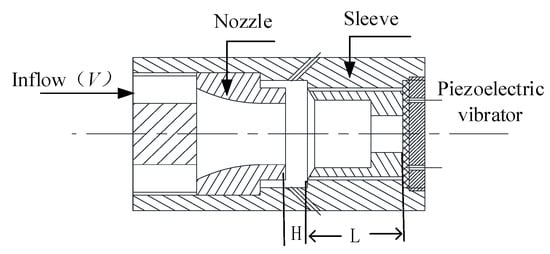
Figure 2.
Structure diagram of the airflow-induced acoustic piezoelectric generator.
3. Acoustic Frequency Calculation and Power Generation Performance Research
3.1. Conditions for Airflow-Induced Sound Waves
When the air flow from the narrow slit is blown to a sharp wedge, a sharp pure tone will occur, which is called the edge tone []. The edge tone is actually a solid that faces a high velocity fluid and splits it left and right, causing instability, and then generates periodic vortices, which can be produced in both gases and liquids. When the high-speed jet emitted by the narrow slit flows through the static fluid, due to the contact between the high-speed flow and the static medium on the boundary of the jet, vortices are continuously generated and pushed toward the static fluid. When it reaches the edge, reflection occurs, and the reflected shock wave returns to the nozzle, which stimulates more vortices, and the edge tone produced is very stable.
The empirical equation of edge tone frequency is:
where represents the frequency of the edge tone, v represents the velocity of the jet, H represents the distance from the nozzle to the wedge, and is the Mach number.
For a small pitch, short resonant cavity acoustic tube, the acoustic modal frequency is calculated based on the propagation of the generated edge tone in the cavity. The sound wave propagates in the cavity, and the disturbance flow field deviates from its average value, which can be expressed as: , , where p represents pressure, ρ represents density, represents the Reynolds time-average pressure, represents the Reynolds time-average density, represents the pressure oscillation component, and represents the density oscillation component. According to the classical acoustic theory [], the three-dimensional acoustic wave equation can be expressed as:
Converting the three-dimensional acoustic wave equation to the one-dimensional standing wave equation gets:
For longitudinal waves, it is necessary to consider the influence of the cavity exit conditions on acoustic characteristics. If we let the sound pressure of x = 0 and the velocity of the particle be and , the sound pressure and particle velocity obtained at the end of the acoustic cavity at x = L are denoted as and , and the natural frequency of the acoustic mode of the resonant cavity can be obtained by the sound wave transmission equation:
By substituting the open end condition = 0, the acoustic mode expression in the resonant cavity can be obtained as:
where k represents the order of the acoustic mode, and L represents the longitudinal length of the cavity.
For the airflow-induced acoustic piezoelectric generator, we put forward a correction plan for L through a large number of experiments, and we proved that the length of L is not only related to the length of the resonant cavity, but is also related to the diameter of the resonant cavity and the distance from the resonant cavity to the wedge. The revised result is:
where f represents the acoustic modal frequency in the cavity, c is the speed of sound, L is the length of the resonant cavity, and ∆L is the correction parameter; we refer to the correction scheme proposed by [] where ∆L = 0.61R and α = 0.4.
It can be seen from Equation (1) that with an increase in flow velocity, the frequency of edge tone production also increases gradually. When the frequency generated by the edge tone is near to the acoustic mode frequency of the resonant cavity, the system will resonate and emit a strong sound. At this time, the vortex–acoustic coupling phenomenon occurs, and the pressure oscillation amplitude increases significantly.
The vorticity acoustic coupling phenomenon is a closed loop system. When the high-speed jet emitted by the narrow slit flows through the static fluid, the boundary of the jet will continuously generate vortices due to the contact between the high-speed flow and the static medium. When a portion of vortexes advance with the jet stream and meet the wedge, more vortexes will be excited and sound will be generated at the same time. When the acoustic signal propagates to the bottom of the resonator, reflection will occur. At this time, the sound signal is fed back to the flow field and has an effect on vortex shedding, and the frequency of the new vortex is adjusted to be consistent with the acoustic modal frequency.
Therefore, the sufficient condition for generating sound waves in the resonant cavity is: .
According to the conditions for generating sound waves in the resonant cavity, , by substituting Equations (1) and (6) into the equation, the following equation can be obtained:
Through simplification, the relationship between structural parameters and flow velocity when sound waves are generated in the resonator must meet the following requirements:
That is, when the length of the resonance cavity (L), the distance from the nozzle to the wedge (H), and the diameter of the resonance cavity (R), and the flow velocity (V) in the generator structural parameters satisfy Equation (8), a stable sound wave can be formed.
3.2. Vibration Model of Airflow-Induced Acoustic Piezoelectric Generator
The acoustic–electric conversion model of the airflow-induced acoustic piezoelectric generator, is shown in Figure 3. The mechanical equivalent model is shown in Figure 3a; the piezoelectric vibrator is firmly connected to the equivalent mass (M), and the lower end face is firmly connected to the cover plate. Suppose the mass of M is m and the displacement is x, it is affected by the external excitation force and internal force, where the internal force refers to the combination of the piezoelectric element’s restoring force, the spring’s resistance and damping force. Then the vibration equation for the piezoelectric vibrator is:
where, F is the excitation force, that is, the acoustic excitation in the resonant cavity, F = F0 sinωt, x is the vibration displacement of the piezoelectric vibrator, c is the equivalent damping coefficient of the acoustic–electric transducer, is the equivalent stiffness of the mechanical system, and is the piezoelectric return force of the acoustic–electric transducer.

Figure 3.
Equivalent model of the airflow-induced acoustic piezoelectric generator.
The piezoelectric vibrator with a relatively thin circular plate (thickness dimension is much smaller than the radius) is designed to work in a stretching vibration mode parallel to the direction of the electric field, and the piezoelectric vibrator is fixedly installed around it. The electromechanical equivalent model is shown in Figure 3b. The circuit is shown in Figure 3c. The surface area and thickness of the piezoelectric sheet are, respectively, A and b, and the output voltage and current are, respectively, V and I. According to the fourth piezoelectric equation shown in reference 9, it is not difficult to obtain the macroscopic relationship between mechanical and electrical quantities as:
is the electrical open-circuit equivalent stiffness of the acoustic–electric transducer, α is the piezoelectric stress factor, is the static clamping capacitance of the acoustic–electric transducer. is the elastic force, and is the voltage control force. We can get: , . If we suppose , , then . Among them: . Then, Equation (9) is transformed into:
According to the initial conditions of the piezoelectric vibrator vibration, , , use to multiply both sides of the Equation (11), and then perform [0, t] to find the definite integral to get:
The right side of Equation (12) is equal to the work done by the excitation force F; the left side of the equation is equal to the system’s kinetic energy, mechanical loss, elastic potential energy and electric energy generated, so the conservation of energy is satisfied.
The fourth item on the left side of Equation (12) is the electric energy converted by the acoustic–electric transducer, and this is denoted as . If the clamping capacitor on the power supply side stores electric energy and circuit loss , there should be a relational expression, , that is:
when the system is open, , so 0, .
If we let , Equation (11) is transformed into:
According to the forced vibration theory, the total solution to Equation (14) is: , among them, is the general solution, is the special solution. They can be expressed as:
In the equation, , , , and are constants, and p is the natural frequency of the transducer.
is only a transient term, which means that the transient vibration of the system decays exponentially and will disappear soon, at the beginning, the amplitude of the system gradually increases, and when disappears, the system will vibrate at a constant amplitude according to .
So when the system is stable:
According to Equation (10), voltage is a function of vibration displacement, so voltage and displacement have consistent frequencies. The frequency of displacement in Equation (17) is consistent with the excitation frequency. It can be concluded that the excitation force frequency, vibration displacement frequency, and voltage frequency are consistent.
4. Acoustic Performance Experiment
4.1. Airflow Induced Acoustic Frequency Experiment
4.1.1. Experimental Prototype Parameters
In accordance with Equation (8), we designed the structure size of the annulus, resonant cavity, and wedge, and selected four experimental prototypes. We took the annulus as X, the distance from the nozzle to the wedge as H, the length of the cavity as L, and the diameter as D. The structure parameters are shown in Table 1.

Table 1.
Structural parameters of the experimental prototype.
By substituting the mechanical parameters of the four experimental prototypes into Equation (4), the jet velocities at resonance were found to be: , , , .
In accordance with Equation (14), we took the speed of sound propagation in the air as: c = 340 m/s, and substituted the calculated velocity at resonance of the four experimental prototypes, respectively, and the resonant frequencies of the prototype were found to be the following: , , , and .
Therefore, when the flow rates of the four experimental prototypes are around 110.27 m/s, 90.67 m/s, 85.57 m/s and 60.28 m/s with the same structural parameters, if sound can be emitted and sound frequencies are detected near 6.94 kHz, 5.96 kHz, 2.85 kHz and 2.13 kHz, it can be considered that acoustic waves have been generated in the resonant cavity and resonance has occurred.
4.1.2. Blowing Simulation Test System
Figure 4 and Figure 5 show the blowing test process and experimental system, respectively; we use an air compressor to blow the air to simulate the external ballistic environment. The pulsation pressure sensor measured the sound pressure curve at the bottom of the cavity, and then recorded the measurement value of the pulsation pressure sensor through the data acquisition card, and the laser displacement sensor recorded the vibration displacement curve of the piezoelectric vibrator, and finally through spectrum analysis, analyzed the sound pressure frequency and the vibration frequency of the piezoelectric vibrator. Figure 6 shows a physical picture of the airflow-induced acoustic piezoelectric generator

Figure 4.
Blowing simulation test process.
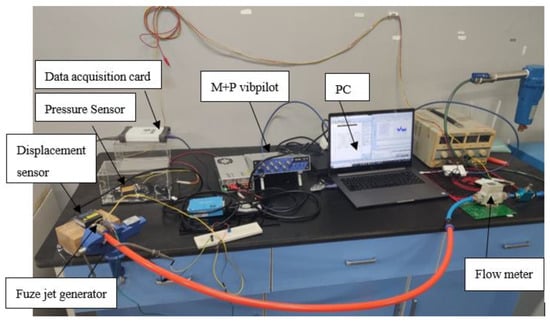
Figure 5.
Blowing experimental test system.
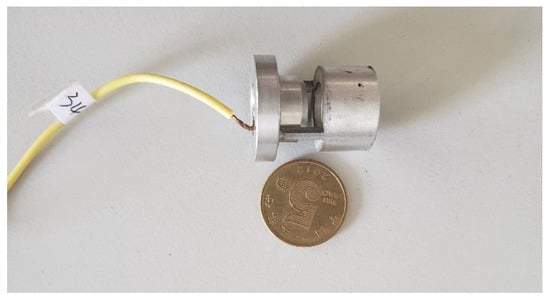
Figure 6.
Physical picture of prototype #1.
4.1.3. Sound Pressure Signal Detection
According to the air compressor experimental process, the sound pressure curves of four experimental prototypes under different flow velocities used in the simulation experiment of the air compressor were verified. Figure 7 shows the sound pressure curve at the bottom of the resonant cavity and the spectrum analysis diagram of the sound pressure curve collected by the data acquisition card under the condition of a flow velocity of 127 m/s for the prototype # 1. In Figure 7, Vmin represents the minimum value, Vmax represents the maximum value, Vpp represents the peak-to-peak value, and F represents the waveform frequency.
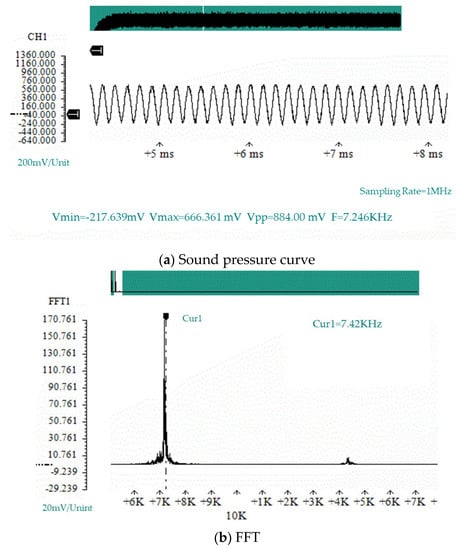
Figure 7.
The sound pressure at the bottom of the resonant cavity of prototype #1 when V = 127 m/s.
According to the sound pressure curve and spectrum analysis diagram shown at the bottom of the resonant cavity in Figure 7, the frequency of the sound pressure vibration was 7.24 kHz. According to the sound pressure curve, the vibration of the sound pressure followed a sinusoidal vibration curve with stable amplitude, which conforms to the assumption of the force given in the acoustic and electrical energy exchange model in Section 3.2.
The sound pressure curves of the four experimental samples in different flow velocity ranges were tested by the same test method and are recorded in Table 2.

Table 2.
Sound pressure parameters at the bottom of the resonant cavity.
Using Table 2, we drew the relationship curve between the sound pressure frequency at the bottom of the resonant cavity and the natural frequency, and fitted the sound pressure frequency curve to calculate the sound pressure frequency value at the resonance flow rate, as shown in Figure 8. represent the measured sound pressure frequency at the bottom of the resonant cavity, and – represent the natural frequency of transducers 1–4.
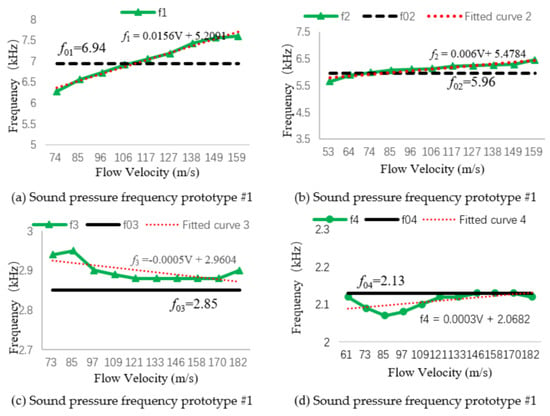
Figure 8.
Sound pressure frequency and first-order resonant frequency.
In accordance with the fitting curve in Figure 8, the resonance flow rates of the four prototypes were substituted into their fitting curve equations. The sound pressure frequency of prototype #1 at its resonance velocity was , the sound pressure frequency of prototype #2 at its resonance velocity was , the sound pressure frequency of prototype #3 at its resonance velocity was , and the sound pressure frequency of prototype #4 at its resonance velocity was . It can be seen from the fitting equation that the slope of the curve gradually decreased, indicating that the longer the resonant cavity, the closer the detected sound pressure frequency value is to the first-order resonance frequency, which verifies the rationality of the structural parameter design presented in Section 3.1.
It can be seen from the table that the prototype did not produce acoustic resonance in all flow velocity ranges. Prototype #1 could only generate sound waves when the flow velocity reached 64 m/s or more, and no sound waves were generated below 64 m/s. When prototype #3 was at 53 m/s, the sound pressure curve could not be detected at the bottom of the resonance cavity. Prototypes #2 and #4 were shown to emit sound at the flow velocities of 53–159 m/s, and a sound pressure curve was detected at the bottom of the resonator cavity. However, for flow velocities higher than 159 m/s, further verification is needed to determine whether the sound phenomenon will be broken. A limitation of the experimental conditions was that the flow velocity could not reach more than 159 m/s; this is an area for future research.
Table 3 shows the actual sound pressure frequency (), the theoretical resonance frequency (), absolute error (∆) and relative error () of the four experimental prototypes near the calculated flow velocity (V).

Table 3.
Actual and theoretical resonance frequency values.
It can be seen from Table 3 that near the calculated sound velocity, all the four experimental prototypes were able to emit sound, and a stable sound pressure waveform was detected at the bottom of the resonant cavity. The relative deviation was within 3%, which is considered consistent with the theoretical calculation shown in Section 3.1.
4.2. Experimental Analysis of Power Generation Performance
4.2.1. Experimental Verification of the Frequency Characteristics
We used prototype #2 to conduct an experimental study of the generation of electric energy. We took three piezoelectric vibrators with similar natural frequencies and installed them on the bottom of the resonant cavity. We used the data acquisition card to collect the open-circuit voltage output of the piezoelectric vibrator, and we used the laser displacement sensor to measure the vibration displacement of the piezoelectric vibrator. Figure 9 and Figure 10 show the voltage curve and displacement curve of the piezoelectric vibrator no. 1 at a flow rate of 100.8 m/s, as well as its spectrum analysis diagram.
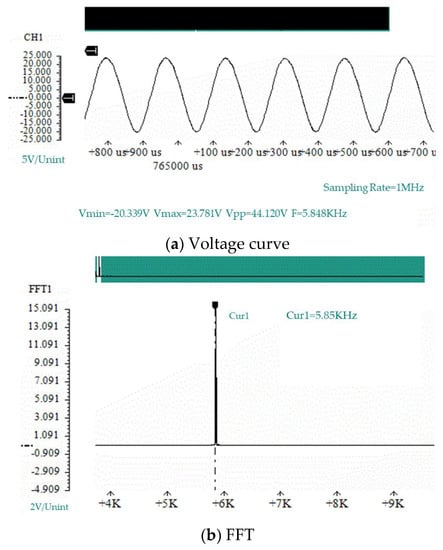
Figure 9.
The open-circuit voltage of piezoelectric vibrator no. 1 of prototype #2 at V = 100.8 m/s.

Figure 10.
The displacement curve of piezoelectric vibrator no. 1 of prototype #2 at V = 100.8 m/s.
For the open-circuit voltage curve of the piezoelectric vibrator, through a spectrum analysis, it was found that the open-circuit voltage frequency was: . The main peak of the displacement vibration frequency of the piezoelectric vibrator was read through the frequency spectrum analysis chart of the displacement curve: . The error between the output open-circuit voltage frequency and the vibration displacement frequency of the piezoelectric vibrator was only 10 Hz, and the relative error was only 0.17%. It can be considered that the two frequencies were consistent. It was shown in Section 3.1 that the sound pressure frequency of prototype #2 at a flow rate of 101 m/s was . The error between the sound pressure frequency and the vibration displacement frequency of the piezoelectric vibrator was 250 Hz, and the relative error was 4.2%. Therefore, it can be considered that the three have consistent frequencies and conform to the calculation results given in Section 3.2.
4.2.2. Generated Power Conversion Efficiency
We connected a 6 kΩ resistor to the output end of the airflow-induced acoustic piezoelectric generator, and recorded the output power of the resistor and the voltage value when the system is open, as shown in Table 4. u represents the peak-to-peak value of the open-circuit voltage of the generator, represents the frequency of the open-circuit voltage, and P represents the output power when the external load of the airflow-induced acoustic piezoelectric generator was 6 kΩ.

Table 4.
Output test data for the generator.
The calculation of the airflow power can be transformed by the kinetic energy equation, into:
where E is kinetic energy, ρ is the air density, v is the jet velocity, ∆t is the observation time, S is nozzle area, and m is the mass.
Through Equation (18), the expression of airflow power can be obtained as:
Therefore, the energy conversion efficiency of the airflow-induced acoustic piezoelectric generator can be expressed as
According to the data presented in Table 4, the maximum energy conversion efficiency of the airflow-induced acoustic piezoelectric generator reached its maximum when the flow velocity was v = 79.79 m/s, and the maximum energy conversion efficiency was η = 4.37‰. At the flow rate of 100.8 m/s, the maximum output power reached its maximum value, Pmax = 5.3 mW, while the average output power of the fuze magnetic rear seat generator was only 0.18 mW []. Therefore, the power of the airflow-induced acoustic piezoelectric generator is much higher than the fuze magnetic rear seat generator. The current rockets projectiles fuze power supply voltage requirement is greater than 6 V, and the small missile fuze power supply voltage requirement is greater than 12 V [,]. According to Table 4, so the effective value of the output voltage is ; this is enough to meet the requirements for the use of rocket projectiles and small missile fuze power.
5. Conclusions
The structural design of the airflow-induced acoustic piezoelectric generator must coordinate with the mechanism of airflow-induced acoustic waves. The condition for airflow-induced acoustic waves is that the edge tone frequency must be equal to the acoustic mode frequency of the resonant cavity. The results of the blowing experiment and parameter test of the airflow-induced acoustic piezoelectric generator, show that the acoustic signal in the resonant cavity is a sinusoidal signal with stable frequency, and the acoustic wave is consistent with the frequency of the piezoelectric vibrator displacement and output voltage. The output power reaches tens of milliwatts, which is enough to meet the requirements for the use of fuze power supplies for rocket projectiles and small missiles, and can effectively solve the problems of low modern fuze power supplies and low output energy.
The structural design scheme of the airflow-induced acoustic piezoelectric generator may be helpful in developing a universal design of the fuze power supply. The three frequency characteristics provide a design idea for a vibration sensor, which can express high-frequency vibration signals that are difficult to directly measure by installing a piezoelectric vibrator and testing the frequency of the open-circuit voltage.
Author Contributions
Conceptualization, Z.L.; methodology, Z.L.; software, Z.L.; validation, J.L.; formal analysis, Z.L.; investigation, Z.L.; resources, H.C.; data curation, Z.L.; writing—original draft preparation, Z.L.; writing—review and editing, Z.L.; visualization, H.C.; supervision, H.C.; project administration, H.C.; funding acquisition, H.C. All authors have read and agreed to the published version of the manuscript.
Funding
This research received no external funding.
Acknowledgments
First and foremost, I would like to show my deepest gratitude to mysupervisor, Hejuan CHEN, a respectable, responsible and resourceful scholar, who has provided me with valuable guidance in every stage of the writing of this thesis. Without her enlightening instruction, impressive kindness and patience, I could not have completed my thesis. I shall extend my thanks to Yinghui LI for all her kindness and help. Last but not least, I’d like to thank all my friends, especially my five lovely roommates, for their encouragement and support.
Conflicts of Interest
The authors declare no conflict of interest.
References
- Zhaowei, J. Research on the Control Technology for Generating Electric Energy from Low-Power Environmental Energy. Master’s Thesis, Nanjing University of Science and Technology, Nanjing, China, 2020. [Google Scholar]
- Abdelkefi, A. Aeroelastic energy harvesting: A review. Int. J. Eng. Sci. 2016, 100, 112–135. [Google Scholar] [CrossRef]
- Rostami, A.B.; Armandei, M. Renewable energy harvesting by vortex-induced motions: Review and benchmarking of technologies. Renew. Sustain. Energy Rev. 2017, 70, 193–214. [Google Scholar] [CrossRef]
- Li, S.; Yuan, J.; Lipson, H. Ambient wind energy harvesting using cross-flow fluttering. J. Appl. Phys. 2011, 109, 26104. [Google Scholar] [CrossRef]
- Xingqiang, Z.; Junlei, W.; Jun, C. Research status of miniature wind energy collectors based on wind-induced vibration effects. J. Vib. Shock China 2017, 36, 106–112. [Google Scholar]
- Robbins, W.P.; Morris, D.; Marusic, I.; Novak, T.O. Wind-Generated Electrical Energy Using Flexible Piezoelectric Mateials; International Mechanical Engineering Congress and Exposition: Chicago, IL, USA, 2006; pp. 1–9. [Google Scholar]
- Akaydın, H.D.; Elvin, N.; Andreopoulos, Y.; Akaydin, H.D. Wake of a cylinder: A paradigm for energy harvesting with piezoelectric materials. Exp. Fluids 2010, 49, 291–304. [Google Scholar] [CrossRef]
- Perez, M.; Boisseau, S.; Gasnier, P.; Willemin, J.; Reboud, J.L. An electret-based aeroelastic flutter energy harvester. Smart Mater. Struct. 2015, 24, 035004. [Google Scholar] [CrossRef]
- Du, Z. Research on Micro Wind Turbine Based on Resonant Cavity Structure. Master’s Thesis, Chongqing University, Chongqing, China, 2012. [Google Scholar]
- Singh, K.; Michelin, S.; De Langre, E. Energy harvesting from axial fluid-elastic instabilities of a cylinder. J. Fluids Struct. 2012, 30, 159–172. [Google Scholar] [CrossRef]
- Dai, H.L.; Abdelkefi, A.; Yang, Y.; Wang, L. Orientation of bluff body for designing efficient energy harvesters from vortex-induced vibrations. Appl. Phys. Lett. 2014, 108, 053902. [Google Scholar] [CrossRef]
- Bryant, M.; Wolff, E.; Garcia, E. Aeroelastic flutter energy harvester design: The sensitivity of the driving instability to system parameters. Smart Mater. Struct. 2011, 20, 125017. [Google Scholar] [CrossRef]
- Hobbs, W.B. Piezoelectric Energy Harvesting: Vortex Induced Vibrations in Plants, Soap Films, and Arrays of Cylinders. Master’s Thesis, Georgia Institute of Technology, Atlanta, GA, USA, 2010; pp. 7–58. [Google Scholar]
- Weinstein, L.A.; Cacan, M.R.; So, P.M.; Wright, P.K. Vortex shedding induced energy harvesting from piezoelectric materials in heating, ventilation and air conditioning flows. Smart Mater. Struct. 2012, 21, 45003. [Google Scholar] [CrossRef]
- Clair, D.S.; Bibó, A.; Sennakesavababu, V.R.; Daqaq, M.F.; Li, G. A scalable concept for micropower generation using flow-induced self-excited oscillations. Appl. Phys. Lett. 2010, 96, 144103. [Google Scholar] [CrossRef]
- Dai, H.; Abdelkefi, A.; Wang, L. Piezoelectric energy harvesting from concurrent vortex-induced vibrations and base excitations. Nonlinear Dyn. 2014, 77, 967–981. [Google Scholar] [CrossRef]
- Abdelkefi, A.; Nuhait, A.O. Modeling and performance analysis of cambered wing-based piezoaeroelastic energy harvesters. Smart Mater. Struct. 2013, 22, 95029. [Google Scholar] [CrossRef]
- Bhattacharya, A.; Shahajhan, S.S.S. Power extraction from vortex-induced angular oscillations of elliptical cylinder. J. Fluids Struct. 2016, 63, 140–154. [Google Scholar] [CrossRef]
- Franzini, G.R.; Bunzel, L.O. A numerical investigation on piezoelectric energy harvesting from Vortex-Induced Vibrations with one and two degrees of freedom. J. Fluids Struct. 2018, 77, 196–212. [Google Scholar] [CrossRef]
- Sobhanirad, S.; Afsharfard, A. Improving application of galloping-based energy harvesters in realistic condition. Arch. Appl. Mech. 2018, 89, 313–328. [Google Scholar] [CrossRef]
- Wang, J.; Tang, L.; Zhao, L.; Zhang, Z. Efficiency investigation on energy harvesting from airflows in HVAC system based on galloping of isosceles triangle sectioned bluff bodies. Energy 2019, 172, 1066–1078. [Google Scholar] [CrossRef]
- Junming, L. Fuze airflow resonance piezoelectric generator. J. Detect. Control China 2009, 31, 23–26. [Google Scholar]
- Kim, S.-H.; Ji, C.-H.; Galle, P.; Herrault, F.; Wu, X.; Lee, J.-H.; Choi, C.-A.; Allen, M.G. An electromagnetic energy scavenger from direct airflow. J. Micromech. Microeng. 2009, 19, 94010. [Google Scholar] [CrossRef]
- Wei, X. Research on the Design of Fuze Micro-Electromechanical Airflow Excitation Power Supply Based on the Principle of Piezoelectric Power Generation. Master’s Thesis, Nanjing University of Science and Technology, Nanjing, China, 2012. [Google Scholar]
- Zou, H. Research on Airflow-Induced Acoustic Vibration Technology of Small Vibrating Piezoelectric Generator. Ph.D. Thesis, Nanjing University of Science and Technology, Nanjing, China, 2015. [Google Scholar]
- Zou, H.; Chen, H.; Zhu, X. Piezoelectric energy harvesting from vibrations induced by jet-resonator system. Mechatronics 2015, 26, 29–35. [Google Scholar] [CrossRef]
- Zou, H.; Song, J.; Wang, Z.; Chen, H. The effects of structural parameters on excitation force of airflow vibration piezoelectric generator. J. Vibroeng. 2018, 20, 2393–2402. [Google Scholar] [CrossRef]
- Chen, H.; Wang, G.; Cai, J.; Sun, J.; Zou, H. Vibration model and frequency characteristics of the piezoelectric transducer in airflow-induced acoustic generator. J. Vibroeng. 2018, 20, 591–601. [Google Scholar] [CrossRef]
- Wang, X. Research on Jet Stream Strong Sound Device. Master’s Thesis, Nanjing University of Science and Technology, Nanjing, China, 2005. [Google Scholar]
- Yang, Y. Research on Engine Pressure Oscillation Caused by Vortex Shedding. Master’s Thesis, Harbin Engineering University, Harbin, China, 2016. [Google Scholar]
- Chunhui, Z. Research on the Power Mechanism and Circuit of the Magnetic Recoil Fuze. Master’s Thesis, Nanjing University of Science and Technology, Nanjing, China, 2012. [Google Scholar]
- Li, S. Introduction to Fuze, 1st ed.; Beijing Institute of Technology Press: Beijing, China, 2017; pp. 222–238. [Google Scholar]
- He, Z.; Li, H. Fuze Mechanism, 1st ed.; Beijing Institute of Technology Press: Beijing, China, 2014; pp. 222–238. [Google Scholar]
© 2020 by the authors. Licensee MDPI, Basel, Switzerland. This article is an open access article distributed under the terms and conditions of the Creative Commons Attribution (CC BY) license (http://creativecommons.org/licenses/by/4.0/).